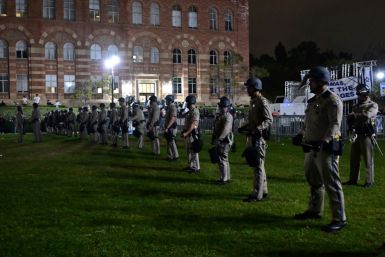Scientists Make Astonishing Discovery Of 'Ghost Particle' In Earth's Atmosphere Proving Alien Life Exists—Report

For centuries, researchers and scientists have been debating on the possibility of existence of alien life. A photo obtained by scientists supposedly provides proof that aliens are real and Earthlings are not alone, according to researchers.
Reporting about the groundbreaking discovery, Daily Express broke the news on Jan. 16, 2015. According to the report, a group of British researchers have discovered a "spectral-like 'ghost-particle' in debris gathered from outer space." They published a photo that reveals the said "latest proof aliens exist."
The discovery has been made by Professor Milton Wainwright and his team of researchers from the University of Sheffield and the University of Buckingham Centre for Astrobiology. He works at the University of Sheffield's Department of Molecular Biology and Biotechnology. This "ghost particle" was reportedly obtained from "dust and particulate matter" found in the stratosphere, the atmospheric layer between troposphere and the mesosphere, of the earth.
They reportedly sent balloons 27km above the Earth's atmosphere to collect debris from space where they stumbled upon the particle. These scientists emphasises that this matter is biological in nature, and it is something that has never been seen before. It is said the discovery of the particle "could hold the key" to the questions about the existence of aliens.
It is termed "ghost particle" because of its wisplike appearance when seen under a microscope. Professor Wainwright explains that the particle comes in "width of human hair" and resembles "a chiffon scarf with a ghostly appearance."
He also speculates that "in its space environment this 'ghost particle' is a living balloon which an alien microscopic organism might inflate with lighter than air gasses allowing it to float in the air or the seas of an unknown space environment." The scientist revealed that even though the photo shows the subject to be more like a deflated balloon, it is probably inflated. It remains to be seen whether the discovery could be used by other researchers, and subsequently open avenues for the study of the related topics, such as origin of life on Earth.
He is amazed at how these particles are available "on the sampling stubs in an absolutely pristine condition with no contamination like pollen grass or pollution particles." Prior to their groundbreaking discovery of "ghost particle," Professor Wainwright and his team made another astonishing discovery of "dragon particle." The finding was published in the Journal of Cosmology.
Addressing the topic in an email to Space.com, Chris Mckay, an astrobiologist at NASA's Ames Research Centre in Moffett Field, suggested the need for more convincing proof supporting the findings. "There is probably truth to the report that they find curious stuff in the atmosphere. The jump to the conclusion that it is alien life is a big jump and would require quite extraordinary proof," Mckay explained.
For questions/comments regarding the article, you may e-mail the writer atj.kaur@IBTimes.com.au






